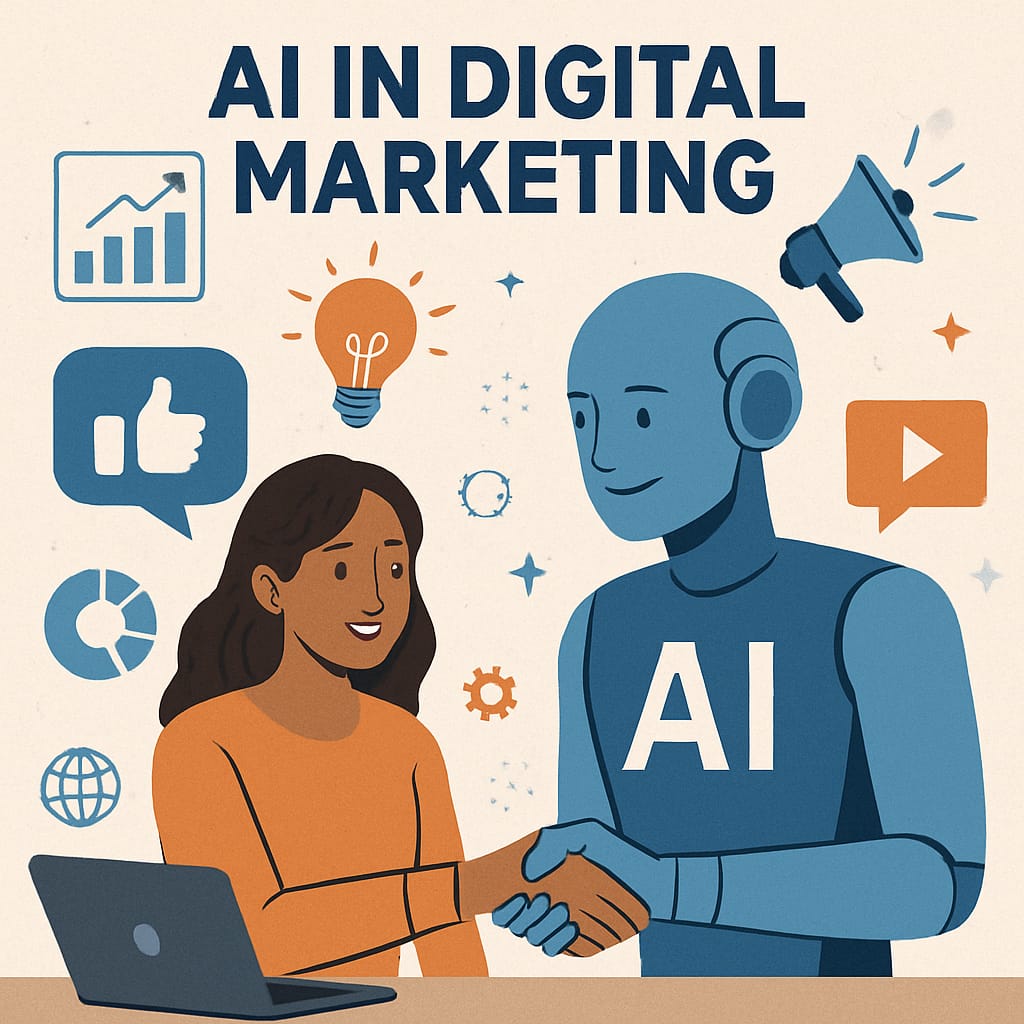How to Use AI in Digital Marketing: Without Losing the Human Touch

Artificial Intelligence (AI) has revolutionized the way we do digital marketing. From automated chatbots to AI-driven analytics and personalized recommendations, businesses can now reach audiences more efficiently than ever. But as machines take over certain tasks, a vital question arises: Can AI replace the human touch in marketing? In this blog, we’ll explain how to use AI in digital marketing while keeping the emotional and personal connection that only humans can provide.
Table of Contents
What Is AI in Digital Marketing?

Before diving deep, let’s clarify what AI in digital marketing means. Artificial Intelligence refers to machines or software that can mimic human intelligence processes. To understand how to use AI in digital marketing effectively, it’s important to know that AI is commonly applied in areas such as:
- Automated content creation
- Predictive analysis
- Chatbots for customer support
- Audience segmentation
- Programmatic advertising
- Personalized email marketing
Learning how to use AI in digital marketing allows marketers to reduce manual work, increase productivity, and make data-driven decisions that enhance campaign performance.
Explain How to Use AI in Digital Marketing
If you’re wondering how to use AI in digital marketing effectively, here are key ways:
Customer Insights & Data Analysis
AI tools can collect and analyze vast amounts of data quickly. Platforms like Google Analytics, HubSpot, and SEMrush now use AI to interpret user behavior, predict trends, and suggest improvements. This helps marketers make smarter, faster decisions.
Chatbots and Virtual Assistants
AI-powered chatbots are available 24/7, providing instant answers to customer queries. For example, many e-commerce websites use bots to guide customers through purchase decisions. Understanding how to use AI in digital marketing effectively includes knowing when to let automation assist and when to involve human support. That’s why it’s essential to provide a smooth transition to a human agent when needed, ensuring a seamless and personalized customer experience.
Email Marketing Automation
AI helps segment email lists and personalize content based on user behavior. Tools like Mailchimp and ActiveCampaign can send personalized messages at the right time, increasing engagement and conversions.
Content Creation and Curation
AI tools like ChatGPT or Jasper AI can generate blogs, product descriptions, and social media captions. While this saves time, adding human editing ensures creativity and emotional appeal are not lost.
Ad Targeting and Optimization
Platforms like Google Ads and Meta (Facebook/Instagram) Ads use AI to deliver ads to the most relevant audiences. By analyzing past behaviors and interests, AI helps maximize ad budgets with better targeting.
How Does AI Lack Human Touch?
Despite its advantages, AI still has limitations—especially when it comes to emotional intelligence. Here’s where AI lacks the human touch:
- Lack of Empathy: AI cannot understand emotional context or empathy like a human.
- Creativity Limits: AI-generated content may be technically correct but often lacks original thought or storytelling.
- Tone and Nuance: AI may misinterpret tone, leading to robotic or insensitive communication.
- Customer Trust: Users often prefer speaking to a human when dealing with complaints, sensitive queries, or unique situations.
That’s why brands must balance automation with genuine human interaction.
Can AI Replace Human Touch in Digital Marketing
Can AI replace human touch? The answer is no—not completely. While AI can automate repetitive tasks and improve efficiency, human marketers are essential for:
- Building emotional connections
- Crafting authentic brand stories
- Understanding cultural nuances
- Delivering empathetic customer service
When understanding how to use AI in digital marketing, it’s important to think of AI as a powerful assistant, not a replacement. It enhances human efforts but can’t replicate human intuition or creativity.
Working with AI Without Losing the Human Touch
Here’s how marketers can work with AI without losing the human touch:
Humanize Your Content
Even if you’re using AI to generate content, always review and edit it with a human voice. Add stories, humor, or emotions that connect with readers.
Use AI for Support, Not Replacement
Let AI handle tasks like data analysis or A/B testing, while your team focuses on strategy, storytelling, and brand-building.
Prioritize Personalization
AI helps with personalization, but ensure it feels genuine. Avoid over-automation. Include names, references to user behavior, or tailored offers, but ensure they align with user interests.
Offer Human Support Options
If you’re using chatbots or automated emails, always provide users the option to talk to a human. This builds trust and improves the customer experience.
Gather Feedback
Regularly ask customers how they feel about your automated tools. Use their insights to improve the balance between AI and human support.
Future of AI and Human Collaboration in Marketing
The future isn’t about humans vs machines—it’s about collaboration. As you explore how to use AI in digital marketing, remember that while AI will continue to advance, the need for authentic, human-driven marketing will always remain.
Brands that combine AI efficiency with human creativity and empathy will stand out. This balanced approach not only improves performance but also builds lasting customer relationships.
Understanding how to use AI in digital marketing means more than just adopting tools—it’s about using them wisely. While AI brings speed, precision, and scalability, the human touch adds emotion, empathy, and authenticity.
So, can AI replace human touch? No. But used correctly, it can empower marketers to do more, with less effort, and still keep it personal.
To succeed in today’s competitive market, focus on working with AI without losing the human touch—because technology may win the click, but humanity wins the heart.
Related blog :AI in digital marketing:How it’s transforming strategies and trends in 2025.

